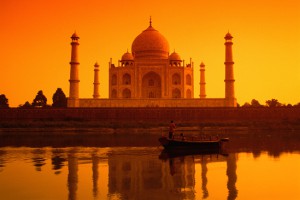How do you express your eternal devotion to the love of your life? Mughal Emperor Shah Jahan enlisted the help of more than 20,000 workers and 1,000 elephants to erect a towering white marble mausoleum dedicated to his wife who died during childbirth. A sunrise visit to the magnificent Taj Mahal, one of the New7Wonders of the World, is just the beginning of your love affair with India. Beyond India’s most sparkling jewel lies a priceless gem mine of experiences you’ll treasure for a lifetime. Hop in a rickshaw for a ride through Delhi’s centuries-old Chandni Chowk bazaar, sit down for traditional Indian cuisine in the home of a noble family in Jaipur, and embark on three thrilling open-air safari game drives through Ranthambore National Park in search of marsh crocodiles, striped hyenas, and the elusive Bengal tiger.
In Udaipur, explore the Jagdish Temple and take a sunset boat ride on Lake Pichola. Tour bustling Mumbai and witness its tiffin lunch box delivery system and visit the former residence of Mahatma Gandhi. Tour the highlights of Kochi and cruise the backwaters of Kerala to witness life along the scenic and serene waterways. A mosaic of memories awaits on this radiant tour of India.
Ranthambore National Park
Ranthambore National Park
The Ranthambhore National Park stretches across an area of 1,334 sq km on the eastern edge of the Thar Desert. Once the hunting grounds of the erstwhile ruling family of Jaipur, today it is one of the last sanctuaries of the big cat, the Royal Bengal Tiger. Ranthambore actually consist of not one, but three, wildlife preserves: the Ranthambore National Park itself, the Sawai Mansingh Sanctuary and the Keladevi Sanctuary.
Ranthambore is an oasis of dense dry deciduous forests amidst a vast tract of semi arid scrub and thorny desert vegetation surrounded by the hills of the Vindhyas and the Aravalis.
An ancient fort lies within the park boundaries of Ranthambore, adding to its charm. Ravines, nallahs, water bodies and waterfalls add to its beauty and offer many natural hideouts for tigers and the other wildlife endemic to this park.
Part of Project Tiger (one of Asia's most important conservation efforts), Ranthambore is the favorite haunt of wildlife buffs and professional wildlife photographers from around the world who come to see tigers, panthers, wild cats, hyena, jackal, marsh crocodile, wild boar, bears, many species of deer and a rich birdlife of over 300 species, including the great Indian horned owl. Ranthambore encompasses three lakes: Raj Bagh, Malik Talab and Padam Talab, where aquatic birds can be seen.
|
|
Kumarakom
Kumarakom
Kumarakom, a small cluster of islands on the backwaters of Vembanad is a popular bird sanctuary and a tourist destination in Kerala, India. The village is abundant in history, rice fields and coconut trees. Visitors can rent and dine onboard a boathouse while cruising through Vembanad Lake, birdwatch at the Vembanad Bird Sanctuary, or munch on local delicacies that emphasizes on exotic spices.
|
|
Jaipur
Jaipur
Jaipur, popularly known as the Pink City, was founded in 1727 AD by one of the greatest rulers of the Kachhawaha clan, the astronomer king Sawai Jai Singh. The pink color was used at the time of making to create an impression of red sandstone buildings of Mughal cities - and repainted in 1876, during the visit of the Prince of Wales. The city is best explored on foot and the adventurous visitor willing to go into the inner lanes can discover a whole new world not visible to the tourist-in-a-hurry.
|
Destination Guide
|
Mumbai
Mumbai
About 300 years ago, the area of Bombay was nothing more than seven islands occupied by small fishing settlements. Today this bustling city offers a seemingly endless array of sights and cultural activities. Mumbai is the glamour of Bollywood cinema, cricket on the maidans on weekends, bhelpuri on the beach at Chowpatty and red double-decker buses. It is also the infamous cages of the red-light district, Asia's largest slums, communalist politics and powerful mafia dons. This pungent drama is played out against a Victorian townscape more reminiscent of a prosperous 19th-century English industrial city than anything you'd expect to find on the edge of the Arabian Sea. Mumbai has vital streetlife, India's best nightlife, and more bazaars than a visitor could ever explore.
|
Destination Guide
|
Udaipur
Udaipur
One of the most romantic cities in Rajasthan, Udaipur is also known as the city of lakes. The marble palaces, beautifully laid out gardens and the lakes make Udaipur seem almost like a mirage in the desert. The founder of Udaipur, Maharana Udai Singh, was overcome by the misfortunes that his old capital of Chittaurgarh had to face due to repeated attacks by the Mughal armies. On the advice of a holy man, Udai Singh shifted his capital to the banks of Lake Pichola- the city was named Udaipur after him.
|
Destination Guide
|
Kochi (Cochin)
Kochi (Cochin)
Kochi (Cochin) is the great, old Keralan spice city. It consists of mainland Ernakulam, islands of Willingdon, Bolgatty and Gundu in the harbor, Fort Cochin and Mattancheri on the southern peninsula and Vypeen Island north of Cochin. Because of the area’s dense tropical forests, extensive ridges and ravines, it has been sheltered from invaders and the rest of India. This encouraged Keralites to welcome maritime contact, and therefore influence from the outside world. In Cochin there is still a small community of descendants from Jewish settlers who fled Palestine 2,000 years ago. When the Portuguese arrived here some 500 years ago, they were surprised to find Christianity already established along this coast. People from far-off lands have been coming to Kerala since ancient times in search of spices, sandalwood and ivory. Such long contact with people from overseas has resulted in the blending of various cultures and has given Keralites a cosmopolitan outlook.
|
Destination Guide
|
Agra
Agra
In the mid 16th century and early 17th century, Agra witnessed a frenzied building activity and it was during this time when the symbol of love Taj Mahal was built. The buildings made during this era were purely in the contemporary Mughal style and of very high quality which is still reflected in what ever monuments remain in Agra. The narrow lanes of Agra filled with aroma of Mughlai cuisine, the craftsman who are busy creating masterpieces with their skill all remind of the Mughal royalty which this city had once experienced. Today whatever remains, has become a major tourist attraction which has taken Agra again to the heights of glory but this time as a major tourist destination of India. Main shopping areas include Taj Mahal complex, Kinari Bazaar, Raja Mandi, Sadar Bazaar. the Gangotri at Taj Mahal Complex and the Up Handlooms, UPICA at the Sanjay place are two UP Government emporiums.
|
Destination Guide
|
Delhi (New Delhi)
Delhi (New Delhi)
Delhi is the third largest city and consists of Old Delhi and New Delhi. Old Delhi was the capital of India Between 17th and 19th centuries and now contains many mosques, monuments and forts relating to India's muslim history. The other Delhi is the imperial city created as the capital of India by the British. In addition to its historic interest and role as government center, Delhi is a major travel gateway. The architectural designs and sophistication that buildings in Delhi like Parliament House, Rashtrapati Bhavan, India Gate, Connaught Place and various administrative buildings like the South and North blocks along the breathtaking view available from Raj Path, show British influence. Modern Delhi has a cosmopolitan culture that nurtures festivals of all faiths and religions. Theatre, drama and entertainment of all sorts including discotheques are there.
|
Destination Guide
|






